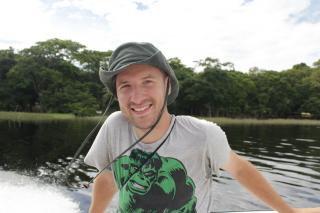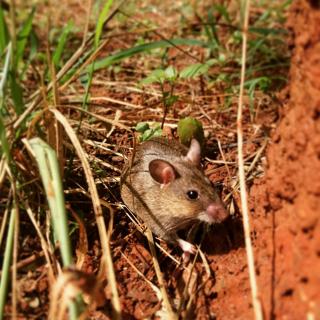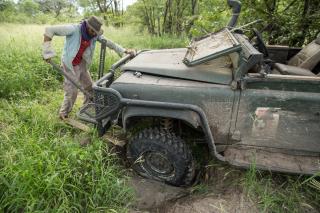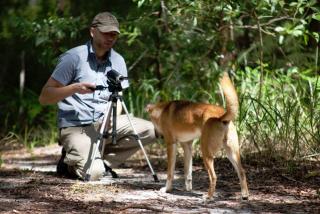Sensors already equip a range of tools to enhance monitoring capacity for conservation. Some of the higher bandwidth technologies, like camera traps and acoustic monitoring systems, have been essential elements of the conservation toolkit for decades, and thus have enough users that we've created dedicated WILDLABS groups to address them. But a whole range of lower bandwidth sensors beyond these core technologies are being increasingly integrated into conservation monitoring systems, and offer rich new insights into the wildlife and ecosystems we're all working to protect. As with many technologies, cost and access have historically been challenges to the adoption of new sensors, but with low-cost and open-source solutions on the rise, we're excited to see what the future of this space holds.
Getting Started with Sensors:
- Watch Shah Selbe's Tech Tutors episode on scaling FieldKit, an open-source conservation sensor toolbox, from a project to a successful conservation tech product.
- Check out our Virtual Meetup about Low-Cost, Open-Source Solutions in conservation tech, including a talk by Alasdair Davies on the Arribada Initiative's work with thermal sensors in early warning systems.
- For a more in-depth introduction, watch the first video in our datalogger mini-series: Freaklabs: How do I get started with Arduino?
In this group, you'll meet others who are using and innovating diverse sensors in their work, discuss ways to make sensors more effective & accessible for conservationists, learn about what sensors are already helping us accomplish in the field, and have the opportunity to ask and answer questions. Join this group to get started!
Header image: Emma Vogel, University of Tromsø
Currently a data scientist in industry working on mechanistic models of risk, previously worked on modeling coral reefs. I am interested in the potential for emerging technologies and new ideas to help us solve environmental crises.
- 0 Resources
- 0 Discussions
- 14 Groups
Fauna & Flora
- 0 Resources
- 3 Discussions
- 10 Groups
- @Phillip_Swart
- | He
I'm a conservationist working in the Vulture conservation space in South Africa with a huge passion for technology.
- 0 Resources
- 0 Discussions
- 18 Groups
Data Scientist/AI Engineer, Birdwatcher, Trail Runner: here to learn about conservation tech & contribute where I can.
- 0 Resources
- 0 Discussions
- 11 Groups
- @ctjack1109
- | He/Him
I am a graduate student at Purdue University developing low-cost IoT technology to measure wetland methane emissions. This, paired with my undergraduate education in Wildlife and Fisheries Resources, has me naturally drawn to advanced tech coupled with conservation issues.
- 0 Resources
- 0 Discussions
- 9 Groups
- @Kyle_Birchard
- | He/Him
Building tools for research and management of insect populations
- 0 Resources
- 0 Discussions
- 6 Groups
- @diego_ellis_soto
- | he/him
University of California & California Academy of Sciences
Biodiversity |Technology | Socio-Ecological Systems | Wildlife Ecology | Remote Sensing | Conservation | K12STEM-education | Music | diegoellissoto.org
- 0 Resources
- 0 Discussions
- 20 Groups
Mechanical Engineer background in test and measurement, IT maintenance consulting, database development, field installation, field maintenance and systems analysis
- 0 Resources
- 0 Discussions
- 7 Groups
- @Alawa
- | She/Her
Passionate wildlife and biodiversity conservationist
- 0 Resources
- 0 Discussions
- 24 Groups
- @CourtneyShuert
- | she/her
I am a behavioural ecologist and eco-physiologist interested in individual differences in marine mammals and other predators


- 0 Resources
- 7 Discussions
- 9 Groups
- @mattaudette
- | he, him, his
Software Tester and Test Automator at Wildlife Protection Solutions
- 0 Resources
- 1 Discussions
- 24 Groups
- @KathHecht
- | she/her
I am a biologist/ecologist without concrete specialisation. New Zealand's unique but fragile flora & fauna have taught me the importance of increasing awareness with locals and visitors alike. This is my constant motivator.
- 0 Resources
- 0 Discussions
- 10 Groups
Community Announcement
Whether you spent the last year working in the field, lab, at home, or virtually, the WILDLABS community's conservation tech achievements were on full display in our annual #Tech4Wildlife Photo Challenge! Relive our...
25 March 2021
National Geographic is offering funding up to up to $50,000 for conservationists conducting research on how the pandemic has impacted wildlife and conservation work. If you are interested in researching aspects of the...
10 March 2021
Article
Today we're celebrating the #Tech4Wildlife Photo Challenge by shining a spotlight on one of our favorite WILDLABS collaboration success stories: the BoomBox! This collaboration between Dr. Meredith Palmer, Jacinta ...
26 February 2021
How can drones and ATVs protect black-footed ferrets from the plague? In this case study from WWF's Northern Great Plains Program, Black-footed Ferret Restoration Manager Kristy Bly discusses how delivering vaccines to...
17 February 2021
Our friends at FieldKit are excited to announce the official launch of the FieldKit! These open source environmental sensing hardware modules are now available for pre-sale in the FieldKit store. You can also read about...
11 February 2021
Last year, Tim van Deursen and Thijs Suijten shared their new "Hack the Poacher" system with us, presenting a unique way to detect poachers in real-time within protected national parks. Read on to learn about their...
29 January 2021
This month, WILDLABS member Drew Cronin shared the new paper "Empowering rangers through technology and innovation." This collaborative effort included several members of the WILDLABS community and leadership, and...
27 January 2021
In this case study from WWF's Northern Great Plains Program, Black-footed Ferret Restoration Manager Kristy Bly discusses how infrared FLIR cameras help teams detect and monitor the highly endangered black-footed...
19 January 2021
As we launch our new Sustainable Fishing Challenges group in the WILDLABS community, we are excited to welcome Daniel Steadman, the group manager, to give us an overview of three major areas in which #tech4wildlife...
4 December 2020
Hey Acoustic Monitoring and AI for Conservation community members - don't miss Rainforest Connection's Species Auto Detection Kaggle competition, open for to competitors and teams now! Participants will have the chance...
24 November 2020
The latest issue of WWF's Conservation Technology Series is about drones and is designed for a broad audience of conservationists. Containing ten case studies, scientific literature, and handy information on getting...
18 November 2020
Community Announcement
WILDLABS is celebrating its five year anniversary! Throughout the rest of 2020, we'll be sharing articles, community features, and case studies showcasing the incredible projects, collaborations, and successes that this...
17 November 2020
September 2024
event
July 2024
16 Products
Recently updated products
117 Products
1 R&D Projects
81 Organisations
Recently updated products
Recently updated R&D Projects
Recently updated organisations
| Description | Activity | Replies | Groups | Updated |
|---|---|---|---|---|
| Hi all, Some ETAG rfid-readers developped by Eli Bridge et al. are now avaible at https://www.labmaker.org/collections/earth-and-ecology/products/etag. The price is high,... |
|
Sensors | 4 years 10 months ago | |
| Hi all, Some ETAG rfid-readers are now avaible at https://www.labmaker.org/collections/earth-and-ecology/products/etag. The price is high, though: USD139. Yvan |
|
Sensors | 4 years 10 months ago | |
| I'd love to chat more! I'll be reaching out soon! |
|
Sensors | 4 years 11 months ago | |
| Yes im hoping the power bank and a few extra mp3s will get it done this year. will look into a better system this winter now that I have some help:) |
|
Sensors | 5 years ago | |
| Please see my edits above |
+4
|
Sensors | 5 years ago | |
| We are developing a Raspberry Pi 4 sized SDR --- frequency range 20Mhz-6GHz. Rx Sensitivity around 120 --- higher is possible with some... |
|
Sensors | 5 years ago | |
| Dear all, I am currently developing a method to extract subgroups from dynamic network data. My current use case is data collected on... |
|
Sensors | 5 years 2 months ago | |
| I need to play a loop of sound to desensitize animals for project. The system needs to be solar powered 24/7 for 2-3 months. I have solar... |
|
Sensors | 5 years 2 months ago | |
| Hi all, we have been developing low cost open source proximity loggers for small animals (minimum logger weight is currently 1g) and we are... |
|
Sensors | 5 years 5 months ago | |
| Hi Alasdair- Currently the Lepton is not on the list. If you would, please fill out the form on this webpage and request the Lepton be added - I will also bring it... |
|
Sensors | 5 years 11 months ago | |
| Hi all, I am currently working on my grad film project, and I'm looking for UK environmental projects using the Raspberry... |
|
Sensors | 6 years ago | |
| Although this article focuses on agriculture in Australia, a lot of the IoT principles that are being used can also possibly be used for... |
|
Sensors | 6 years ago |
Announcing the Conservation Technology Award
4 May 2021 12:00am
WWF: Carnivore Collaring in Zambia
28 April 2021 12:00am
Webinar: Mission Possible: Deployment
 Wildlife Acoustics
Wildlife Acoustics
21 April 2021 12:00am
Margo Gadfly: A Versatile Wildlife Deterrent
31 March 2021 12:00am
The 2021 #Tech4Wildlife Photo Challenge: Community Highlights
25 March 2021 12:00am
Event: 2021 Open Hardware Summit
22 March 2021 12:00am
Arm technologies: What do you use?
10 February 2021 9:07pm
1 March 2021 12:33am
I've been tinkering with NVidia Jetson boards for about 2 years now. This is basically a small ARM computer, comes with an Ubuntu image but could run any linux I think. It's basically a mini computer with an Nvidia GPU, so you can do all sorts of things at 'the edge'.
I have been (on and off) building a bird feeder camera that would id birds and send just the text not images. Ultimately I would like to build a smart camera trap that would id animals and conserve bandwith by just uploading the data.
I started with the Jetson Nano, about 100 USD but when I started it was difficult to do things due to ARM.
Now I am working with a Jetson NX, about 500 USD and things are way easier. Visual Studio Code runs there natively, as do many python libraries and there are even a lot of containers ready made now.
Also, AWS has Graviton instances now - an EC2 ARM computer. One of my plans is to use AWS for building, testing, etc. and now ARM is an option there too.
12 March 2021 7:08pm
Hi Barry,
I am tinkering with similar edge devices and aspirations! I recently acquired the Jetson Nano to start testing some aspects of the BearID Project software pipeline. What were the main issues with the Nano? Is it mainly the build process (speed and memory)? The NX uses very similar CPU cores (but 6 instead of 4), bigger/faster DRAM (8GB vs 4GB) and much faster GPU (especially if you are using INT8 instead of FLOAT32). I'm also playing around with Raspberry Pi and a hardware accelerator.
The Arm-based EC2 instances on AWS should be a great help in compilation!
Full disclosure: I work for Arm, but developing on these platforms is not part of my role there. This is purely a passion project!
Ed
Funding Opportunity: COVID-19 Science Fund
10 March 2021 12:00am
Method for mapping & finding nest boxes
29 September 2020 12:03pm
1 March 2021 11:10am
I don't know much about them either. I do not think they need to face a certain way.
I am pretty sure they can be bougt in bulk. That is what the outdoor clothes companies do.
Try contacting Dale Atkins from RECCO.
2 March 2021 2:52am
Hi Lars, Nida,
Riffing on the Recco idea, if you have access to the detector, it's possible to make a Recco-compatible reflector for very cheap, since for this purpose it won't need to be sewn into clothing or put through a washing machine. There is no magic behind the reflector technology, I think it can be made in small quantities for USD1-2/each. It is basically RFID technology, and you know how cheap they're trying to be. Here is a paper talking about just that. Especially take a look at their reference [4], which details an attempt at making Recco-compatible reflectors, but using older components (the paper was published in 1997). There are much better components now.
I bet Recco detectors are expensive. But there's a way around that! 434MHz transmitters and 868MHz receivers are easy to get; together, these constitute the detector. Another possibility is 13.56MHz/27.2MHz. Not sure about the detection range though.
Thanks,
-harold
9 March 2021 9:26am
Thanks for the paper Harold, this looks like a possibility. Especially if there's a way to make bespoke detectors
Virtual Event: FieldKit Open House
9 March 2021 12:00am
Virtual Event: Carnivores and Camera Traps
4 March 2021 12:00am
Looking for old/dummy Vectronics collars
3 March 2021 8:07am
Collaboration Spotlight: BoomBox
 Ellie Warren
and 2 more
Ellie Warren
and 2 more
26 February 2021 12:00am
WWF: Protecting Ferrets with Drones and Vaccines
17 February 2021 12:00am
News: FieldKit Presales and WSJ Feature
11 February 2021 12:00am
How do I get started with LoRa? Connectivity in conservation
1 February 2021 12:00am
Protecting Wildlife with Machine Learning
29 January 2021 12:00am
New Paper: Empowering Rangers Through Technology and Innovation
27 January 2021 12:00am
WWF: Using Technology to Detect and Protect the Endangered Black-Footed Ferret
19 January 2021 12:00am
Sustainable Fishing Challenges: Fish Catch Monitoring
4 December 2020 12:00am
Making the Most of Tech Tutors Season 2!
30 November 2020 12:00am
Kaggle Competition: Species Audio Detection
24 November 2020 12:00am
WILDLABS Tech Tutors: Season Two
24 November 2020 12:00am
Conservation Technology User Guidelines Issue 5: Drones
18 November 2020 12:00am
WILDLABS: Building a Better World with ‘Bad’ Data
17 November 2020 12:00am
Water intermittency data logger
10 December 2018 4:23pm
18 January 2019 7:21pm
Hello Erick
A few comments that you may find useful.
Before I start, I am not a complete Arduino beginner but I am certainly no expert either.
I quote British suppliers' websites below but you should find some local to you that offer the same components. If in doubt you can always try Mouser or Digikey (though mind the delivery charges for low value orders).
ARDUINO
1. SIZE - If you want to keep things small and do without a lot of the connectors etc. that come with the "standard" Arduino UNO then have a look at the ARDUINO PRO MINI. A postage stamp size unit with plenty of digital and analogue input/output as well as onboard voltage regulator to give you some flexibility on power supply.
Having said that, you already found out that by default Arduinos are not that energy efficient. But there is help at hand if you don' t mind getting a little more immersed in the electronics. See here for a very useful and detailed tutorial that worked a treat for one of my projects:
http://www.home-automation-community.com/arduino-low-power-how-to-run-atmega328p-for-a-year-on-coin-cell-battery/
2. OPERATING VOLTAGE AND CPU SPEED - There are Arduino Pro Mini versions operating at 3.3 or 5V, 8 or 16 MHz. Unless you need lots of processing power (unlikely from your description), then the 8 MHz version will do perfectly well. Pick the voltage version depending on the peripherals you are going to use. There are usually, but not always, 3.3 and 5V versions. SD card readers, for example, operate at 3.3V and those suited for a 5V Arduino have onboard level shifters to convert voltage levels.
http://www.hobbytronics.co.uk/index.php?route=product/search&keyword=arduino%20pro%20mini
3. SAVING ENERGY - I guess you don't need continuous measurements but just, say, once an hour. In so far, you could use slightly more energy-intensive measurement devices as they (and the Arduino) will only ever run for a few seconds at a time. On that note, you should be able to power all or at least some of the peripherals off output pins of the Arduino. They only supply a few 10mA but this is enough in most cases. Use two outpins per device, one set to LOW (for 0V) and one set to HIGH (for 3.3 or 5 V). Larger devices would have to be switched on and off through a transistor or even relay that is controlled by the Arduino.
REAL TIME CLOCK
Beware of some of the cheaper RTCs. I found to my detriment that, e.g. DS1302, does not keep time well at all to the point of being entirely useless. Better spend a few bob more and get something like the DS3234, which worked fine for me.
http://www.hobbytronics.co.uk/rtc-ds3234?keyword=rtc
MEASURING WATER FLOWS
If at all possible, measure contactless. As soon as you get your sensor anywhere near the actual stream, you are exposing it to all manner of potential trouble including debris getting washed onto it, clogging any mechanical sensor and possible upsetting most other "direct contact" sensors. Having said that, there don't seem to be all that many off-the-shelf options so here are some ideas off the top of my head.
Digikey sells the same sensors previously suggested from Adafruit but they also have a range of other "immersible" sensors that are lot cheaper:
https://www.digikey.com/products/en/sensors-transducers/optical-sensors-photointerrupters-slot-type-transistor-output/548?k=optical%20liquid%20sensor
A waterproof capacitive sensors may be an option but this would have to be helddown or burried on the stream bed:
https://www.ebay.com/itm/DC-5-24V-Contactless-Liquid-Level-Sensor-Switch-Non-Contact-Waterproof-Detector-/122834485435
An entirely different approach but definitely non-contact: use a small camera module and machine vision to detect the change of state between dry and wet. To do the processing of this on an Arduino would likely be a challenge, then again, what you are looking for is quite a simple change in visual appearance that may be possible to detect without too much processing.
POWER SUPPLY
If you are operating in the desert then I expect a small solar panel with battery should provide you all the power you need for such a small unit. I can't give you much more details on something custom-made but if you want to keep things simple then use an off-the-shelf device with a USB-style connector (get the 5V Arduino in this case). Better yet, use something that has something more robust than a USB port. If all else fails, use something like Sugru to beef-up the USB socket and plug against accidental damage and disconnection.
https://sugru.com/
Good luck and do have fun !!
J
21 January 2019 3:21pm
Hi @j.neff! These are great tips. I am floored by the generosity of this community, thank you! My progress on this project has been slightly stalled - but I just received the components to solder together the RTC that @Alasdair recommended. Hopefully I can get back onto that train soon, as summer is rapidly approaching!
Thanks for sending these other components and ideas, I will update this thread as soon as a beta version of this device is complete!
All the best,
Erick
13 November 2020 7:18am
Really interesting chat.
I was looking at this "eTape" to measure inundation on marine turtle nests.
https://www.adafruit.com/product/463
Will give you water presence and level if you are interested in more than just presence-absence.
The water level reading seems to be continue, but I guess it can be logged or powered only at requested intervals.
Good luck
Hackathon Opportunity: Vaquita Hacks
10 November 2020 12:00am
Tree Canopy Tools workshop
29 October 2020 5:10pm
RSEC Journal: Ecoacoustics and Biodiversity Monitoring
28 October 2020 12:00am
Leg band-style tags...but for mammals
16 October 2020 4:06am
26 October 2020 2:23pm
Hi Rob,
I can't think of any examples of this with primates, mostly because they'd probably figure out how to get them off or mess with them. Using collars at least limits the biting possibilities but still, they're dang smart! It would be hard I think to ruggedize it enough to deal with all that but then still have it be light-weight and non-bothersome enough to ethically use it (particularly with smaller mammals). Just some thoughts on the practicality aspect for primates; can't speak to other mammals but seems like this would be a similar issues for carnivore species.
-Carly
27 October 2020 2:01pm
Hello Rob,
I have seen the bracelet style used on large mammals with mixed success and failure. The main considerations are terrain the animal uses, and fitting the bracelet properly. Both affect the 1. durability of the tag and 2. whether it cuts into the skin. In the case of fitting to the leg, tighter is better to minimise rubbing and cutting in, but it will depend on the species you are thinking to tag. Would be great to hear how the development goes for small-medium size mammals.
Best,
Michelle






















































11 February 2021 3:45am
Hi Ellie.
This isn't necessarily wildlife but Jacinta and I used the CC1310 wireless chip with the ARM Cortex M3 inside for a project with the International Rice Research Institute. It was to test precision irrigation on rice crops for dry planting and to remove the need for the traditional flood based planting systems. This allows rice to grow in arid regions that traditionally can't support rice as a staple crop. Water scarcity is also a worry for the institute due to global warming, hence focusing on growing rice in low-water environments. There's more information on it here.
For those interested, the CC1310 uses 900 MHz and supports the IEEE 802.15.4 standard. It's one of the standard chips used in the SigFox protocol, although we mainly just used it for communications and not for SigFox implementation. We also implemented a gateway device that collected data from the networked rice paddies and sent water level data to the government server via GSM using SMS. We typically use HTTP but in the Philippines, cellular internet isn't as reliable as SMS, especially in rural areas. Both boards are based on the ARM Cortex M3.
I've attached pics of the wireless sensor boards and gateway we developed for this project as well.
Akiba